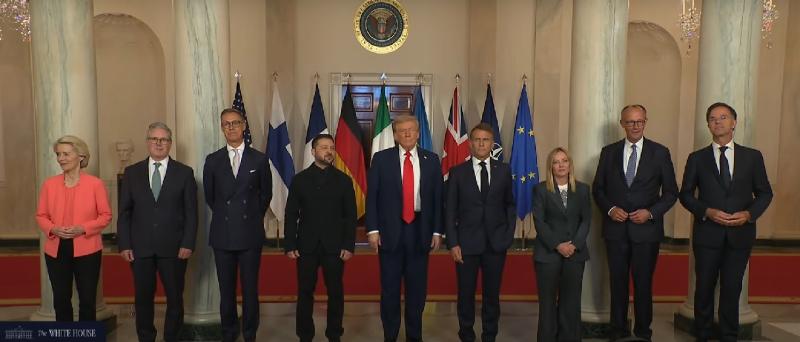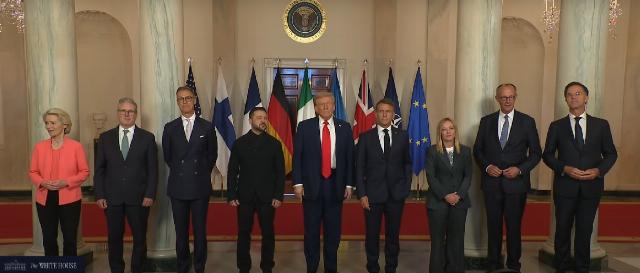


As Winston Churchill once noted, “The only thing worse than having allies is not having allies.” As a cabinet member during World War I (during which he also served for a while in the trenches in France) and British prime minister during World War II and the early Cold War, he knew firsthand the disagreements within but then the ultimate triumph of strong alliances.
President Donald Trump knows both facets as well. His White House gathering of the leaders of the major nations of Europe followed weeks of heated negotiations over trade problems between the United States and the European Union. But the group photo on August 18, with President Trump in the center with Ukrainian Hero-President Volodymyr Zelensky on his right and NATO Secretary-General Mark Rutte on his left sent a powerful message that the West was united against the aggression of Russia.
President Trump’s pledge to support NATO-member troops on the ground in Ukraine with American airpower as part of a security guarantee, along with his earlier deal to develop and profit from Ukrainian rare earth elements critical to advanced technology, means America remains actively engaged in European defense strategy as the leader of the Free World. This role that dominated the 20th century was in full view as the leaders of the major nations sat crowded around the Resolute Desk in the Oval Office.
Ukraine is not a one-off situation any more than Israel is, or any of the other conflict zones around the world. As the lead nation in the lead civilization of the modern world, the U.S. operates with its allies across the globe. A week before the White House meeting, the U.S., UK, and Japan conducted a major joint naval operation in the Philippine Sea, an area marked by Chinese aggression. Two American, one British, and one Japanese aircraft carrier launched their U.S.-made F-35 fighter planes in a massive show of force. The British Carrier Strike Group 2025 had sailed from the UK to take part in this and other joint operations with aligned nations along its the way around the world including India. Sailing from Europe as part of CSG 2025 are warships from NATO-partners Spain and Norway. Joining the group at various times have been warships from the former British Empire states of Canada, Australia, and New Zealand.
In February, a French carrier strike group conducted joint exercises with the U.S. 7th Fleet and Japanese forces in the Philippine Sea. The Chinese Communist Party media outlet Global Times denounced this as “aggravating tensions” in the region. Beijing opposes any European interest in Asia. On the same day as the White House meeting, Global Times denounced remarks by German Foreign Minister Johann Wadephul in Japan claiming China had issued public threats in the Taiwan Straits, the East China Sea, and the South China Sea. He specifically called attention to "China's behavior in the Taiwan Straits is aggressive" and stated "Germany and Japan are standing together against the crisis of the global security environment caused by Russia and China." Beijing’s Foreign Ministry reiterated its false claim that the fate of Taiwan was purely an “internal affair,” as if Taiwan has not been a very successful self-ruled island state for over 75 years. China is particularly sensitive to German remarks, having long considered Berlin to be the bellwether of European opinion, which under former chancellor Angela Merkel had been uninterested in strategic policy. But the first Trump administration had pushed NATO to get involved in Asia, as laid out in the NATO 2030 position paper.

Global Times was correct on one point, these naval deployments are meant to show “Europe's military value and strategic stance in the context of security in the Asia-Pacific to the US, thereby seeking to secure the US' continued deep commitment to NATO and European security.” This is also true of the joint operations China has been conducting with Russia including one this month in the Western Pacific. Though these exercises have been smaller than those conducted between the U.S. and its allies, they have not been inconsequential as demonstrations of unity against the West. Some have even involved joint flights of nuclear-capable strategic bombers. Moscow hopes by showing support for Beijing’s ambitions in Asia, it will get more support for its invasion of Ukraine.
It should be remembered just 20 days before Russia attacked Ukraine, Chinese President Xi Jinping hosted Russian President Vladimir Putin at the opening of the Olympic Games in Beijing. The two leaders issued a joint statement declaring that China and Russia’s bilateral partnership was greater than a traditional alliance and that their friendship would know “no limits.” Putin has received vital support for his aggression from his allies. Weapons from Iran, troops from North Korea and money plus industrial supplies from China. Yet Beijing has not made anything public displays on a par with President Trump’s meeting with NATO and EU leaders. Putin had assured Xi that victory would be quick in Ukraine with minimal Western response. When this proved not to be the case, Xi had second thoughts about any deep association with a losing cause that has provoked Western mobilization. Everyone knows that how things play out in Ukraine will affect how Beijing thinks about a possible invasion of Taiwan.
Xi had ordered his military to be ready to invade Taiwan by 2027, but President Trump says Xi told him that he would not invade during Trump’s term. That is another benefit of a credible “peace through strength” posture. During these coming years, the increased military spending and defense industry expansion on both sides of the Atlantic that President Trump has instigated will hopefully continue to give Beijing pause even after 2028 if his successor keeps these positive trends moving forward. Vice President J.D. Vance is the odds-on favorite to be that successor, but as a senator expressed what many considered an ignorant view of alliances and America’s leadership in the world. Hopefully, he will have learned better watching events like the August 18 Oval Office meeting.
In Alaska, Putin again claimed he attacked Ukraine to block NATO expansion, which he saw as a threat to his revanchist ambitions. NATO “expands” when free nations, with centuries of painful experience, join a collective security organization to defend against Russia, which has always expanded by fire and sword. Putin has proven these concerns were valid. The free nations of Asia also have a long history of war and empire. They correctly see China as a threat, with ties to other violent regimes in Russia, Iran and North Korea that undermine Beijing’s image as a lover of peace. NATO expansion into Asia is thus also warranted in conjunction with the network of alliances the U.S. already leads there.
That NATO conducts exercises with India is crucial. The Quad alignment of India with Japan, Australia, and the U.S. tips the balance of power in Asia in our favor. Australia is also supplementing its own shipbuilding by ordering frigates from South Korea and Japan, an idea that is gaining attention in the U.S.
As the great ancient writer on war and strategy Thucydides noted, “What encourages men who are invited to join a conflict is clearly not the good will of those who summon them to their side, but a decided superiority in power.” The American alliance system combines the most advanced and wealthiest nations on the planet into a common front against common enemies who cannot match their strength when exercised by resolute leadership. Adversaries constantly work to break up this network, but the advantages of alliances are so obvious, their attempts will continue to prove futile.
William R. Hawkins is a former economics professor who has worked for several Washington think tanks and on the Republican staff of the U.S. House Foreign Affairs Committee. He has written widely on international economics and national security issues for both professional and popular publications including for the Army War College, the U.S. Naval Institute, the National Defense University, and The National Interest among others.
Image: White House
